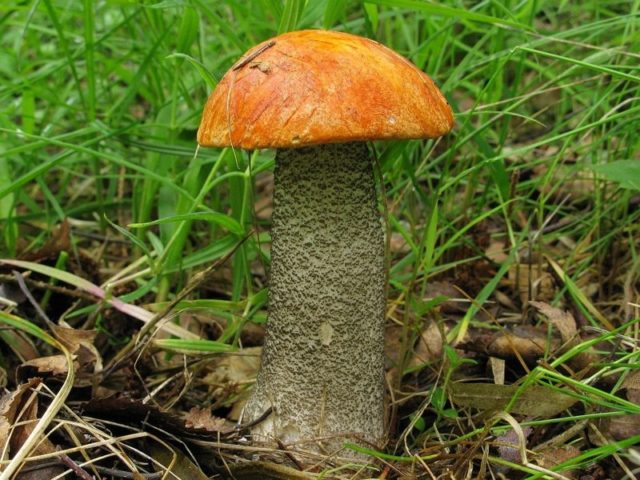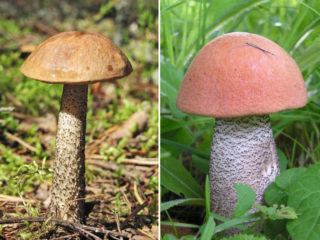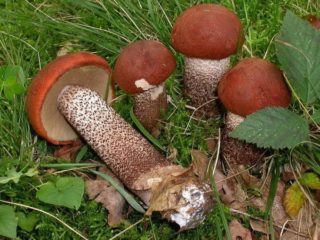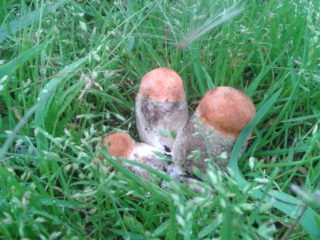Content
Yellow-brown boletus (Leccinum versipelle) is a beautiful, bright mushroom that grows to a very large size. He was also called:
- Boletus versipellis, known since the beginning of the 19th century;
- Leccinum testaceoscabrum, introduced into use in the mid-20th century.
Russian names: multi-skinned boletus and red-brown boletus. Belongs to the Boletov family and the Obabkov clan.

Yellow-brown boletus in a willow-aspen forest
What yellow-brown boletuses look like
The newly emerged yellow-brown boletus has a spherical cap with the edges pressed to the stem. As it grows, it first acquires a flattened toroidal shape, with the edges still pressed. Then it straightens out, taking on the appearance of an almost regular hemisphere. In a mature mushroom, the edges of the cap may curve upward noticeably, forming an irregular shape resembling a pillow.
Cap colors: orange-ocher, yellowish-brown, yellow-brown or sandy-reddish. It grows from 4-8 to 15-20 cm. The surface is dry, with a slight gloss or matte, smooth-satin, can be smooth or with noticeable ribbed lines, grooves, and depressions. The pulp is white, slightly grayish, fleshy. The tubular layer has a white-cream, grayish color with a greenish-yellow tint and is easily separated from the cap. The pores are small, the surface is velvety to the touch. The thickness of the layer is from 0.8 to 3 cm. The spores are olive-brown, fusiform, smooth.
The stem is cylindrical, slightly tapering at the cap and thickened at the root. It has a characteristic color: white or grayish, with brown-black, frequent scales. Thick, with a diameter from 2 cm to 7 cm, a height from 2.5-5 cm to 20-35 cm. The pulp is dense, elastic.

Sometimes yellow-brown boletus can be found in meadows and grass
Where do yellow-brown boletuses grow?
The distribution area of the yellow-brown Boletus is quite extensive, covering the north-temperate climate zone. It can often be seen in Siberia, the Urals, and the central part of Russia. Loves both deciduous and mixed spruce-birch forests and pine forests.
Yellow-brown boletus grows both singly and in groups of up to 20 fruiting bodies. Loves damp places and fertile soils rich in leaf humus. Mushrooms appear from June to October, sometimes even before the first snow. As a rule, it grows in one place for many years.
Is it possible to eat yellow-brown boletuses?
The mushroom is edible. It is readily collected, used to prepare a variety of dishes, and stored for future use. He is classified in the second category. The pulp has a pleasant mushroom aroma and a slightly starchy, sweetish taste that goes well with any food. It is very rarely attacked by insect larvae, which is a definite plus.
False twins of yellow-brown boletuses
The yellow-brown boletus is very similar to representatives of its species. It has no poisonous counterparts. Thanks to the original surface of the stem, it is difficult to confuse it with other fruiting bodies.
Inexperienced mushroom pickers can take gall mushroom (Gorchak) for yellow-brown boletus. It is not poisonous or toxic, but is classified as an inedible species due to its distinct bitterness. The cap is cushion-shaped, the color of the flesh is bluish-white and turns pink when broken.

It is easy to distinguish bitterweed: there are no velvety black scales on the stem, instead there is a characteristic mesh
Red boletus. Edible.It is distinguished by a more saturated reddish or brown tint of the cap, a thick stem with grayish, less pronounced scales.

Family of red aspen boletuses in a clover field
Boletus. Edible. It can be distinguished by its brownish-brown or reddish color and the shape of the spores.

The legs of the boletus are the same as those of the yellow-brown boletus
Collection rules
Young, not overgrown fruiting bodies are best suited for culinary processing. They have more tender, elastic flesh and a rich taste. Any specimen is suitable for drying or mushroom powder.
Since the strong stem sits deep in the soil, it is impossible to pull out or break the mushroom. Found fruiting bodies should be carefully cut off at the root with a sharp knife, or, having dug around to the base, carefully turn them out of the nest, making sure to then cover the hole.
Under no circumstances should you collect dried or rotten specimens. As well as those that grew up next to a busy highway, industrial plant, or near a landfill.

Young mushrooms have a very characteristic appearance
Use
Yellow-brown boletus can be consumed in any form: prepare soup and main courses, freeze, dry, pickle.
Dried yellow-brown boletus soup with vermicelli
An excellent, hearty soup that is not inferior in nutritional value to meat stew.
Required Products:
- potatoes – 750 g;
- vermicelli or spaghetti – 140-170 g;
- dry mushrooms – 60 g;
- onion – 140 g;
- carrots – 140 g;
- garlic – 2-4 cloves;
- bay leaf – 3 pcs.;
- vegetable oil – 40 ml;
- salt – 8 g;
- water – 2.7 l;
- pepper.
How to cook:
- Pour warm water over the mushrooms for 15-30 minutes, rinse well. Cut into thin strips or grind in a blender - as you like.
- Wash and peel the vegetables. Cut the onion and potatoes into strips. Chop the garlic. Chop or grate carrots coarsely.
- Place a pot of water on the stove and boil. Add mushrooms, cook over low heat for 30 minutes.
- Heat oil, add onion, fry, add carrots, add salt, add garlic and pepper.
- Add potatoes to mushrooms, add salt, cook for 15 minutes.
- Place the fry, boil, add noodles and cook until done. Add bay leaf 5 minutes before.

The finished soup can be served with sour cream and fresh herbs
Yellow-brown boletus fried with sour cream
An excellent quick dish that is not at all difficult to prepare.
Required Products:
- mushrooms – 1.1 kg;
- onion – 240 g;
- sour cream – 250-300 ml;
- vegetable oil – 60 ml;
- flour – 60 g;
- salt – 8-12 g;
- pepper and greens.
How to cook:
- Cut the washed mushrooms into pieces and roll in flour, place in hot oil in a frying pan, and fry over medium heat until crusty.
- Wash the onion, chop and fry separately until transparent, combine with mushrooms.
- Add salt, pepper, pour in sour cream, close the lid, simmer over low heat for 18-25 minutes.
The finished dish can be served with herbs.

The aroma and taste of this dish is amazing
Yellow-brown boletus pickled without sterilization
Yellow-brown boletuses, prepared for the winter, are a very popular snack both on the everyday table and on holidays.
Required Products:
- mushrooms – 2.5 kg;
- water – 1.1-1.3 l;
- coarse gray salt – 100-120 g;
- sugar – 120 g;
- vinegar 9% – 160 ml;
- cloves – 10 buds;
- mixture of peppercorns - 1 package;
- bay leaf – 10-15 pcs.
How to cook:
- Cut the mushrooms into large pieces, place in salted water and boil for 30 minutes, skimming off the foam. Pour into a sieve and rinse.
- Place in a saucepan and add water to cover the mushrooms, add all the spices except vinegar.
- Bring to a boil, cook over low heat, covered, for 20 minutes. Pour in vinegar. It is worth taking a sample of the resulting marinade. If something is missing, add to taste.
- Place in sterilized jars, adding marinade to the neck. Seal tightly, turn over and wrap in a blanket for a day.
You can store harvested mushrooms in a cool room without access to sunlight for 6 months.

Pickled boletus in winter
Conclusion
The yellow-brown boletus is a valuable edible mushroom, very popular among lovers of quiet hunting. Thanks to its bright cap and black and white stem, it is clearly visible and easy to distinguish. Grows in temperate climates throughout Russia, Europe and North America. It grows adjacent to birch on well-moistened, fertile soils, but does not like bog peat. You can cook dishes from it, freeze, pickle, and dry. A particularly abundant harvest of these fruiting bodies can be collected in early September in young forest plantations.








